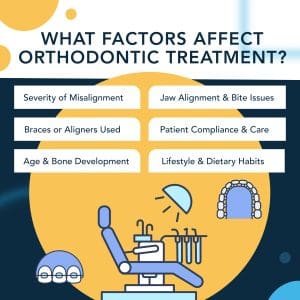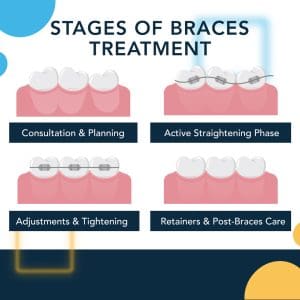Braces are a highly effective solution for correcting misaligned teeth and improving bite function, but one of the most common questions patients have is, “How long will my treatment take?” The truth is, the timeline for braces varies based on several factors, including the severity of misalignment, the type of braces used, and individual response to treatment.
While some patients may achieve results in as little as six months, others may require a few years for optimal alignment. In this guide, we’ll break down the factors that influence treatment time, what to expect at each stage, and ways to potentially speed up the process.
What are Orthodontic Braces?
Braces are one of the most effective ways to straighten teeth and create a healthier, more confident smile. They work by gently applying pressure over time, gradually moving teeth into their ideal positions. Whether you’re dealing with crowding, gaps, or bite issues, braces can help correct alignment and improve overall dental health.
There are different types of braces to choose from, including traditional metal braces, clear ceramic braces, lingual braces (placed behind the teeth), and Invisalign aligners. Each option has its benefits, and your orthodontist can help you find the best fit for your needs and lifestyle.
What Factors Affect Orthodontic Treatment?
The length of time you’ll need braces depends on several factors unique to your teeth and overall oral health. While some people complete their treatment in a year, others may require two or more years to achieve the best results. The complexity of your case, the type of braces you choose, and how well you follow your orthodontist’s recommendations all play a role in determining your treatment timeline. Below are the key factors that can affect how long your braces will take to straighten your teeth.
 Severity of Misalignment
Severity of Misalignment
The more misaligned your teeth are, the longer it may take to straighten them. Minor crowding or small gaps might be corrected in as little as six months, while severe misalignment, rotated teeth, or bite issues could take two years or more to fully correct. Your orthodontist will assess your case and provide an estimated treatment timeline based on your specific needs.
Type of Braces or Aligners Used
Different types of braces work at different speeds. Traditional metal braces tend to be the most efficient for complex cases, while clear aligners like Invisalign can be a more subtle option but may take longer for significant corrections. Ceramic braces offer a discreet alternative to metal braces, but they may require more adjustments, potentially extending treatment time.
Age and Bone Development
Age plays a significant role in how quickly braces work. Since children and teenagers have softer, more adaptable jawbones, their teeth typically move faster than adults. That doesn’t mean adults can’t achieve great results, it just may take a little longer because their bones are denser and less flexible. However, with advancements in orthodontic technology, adult treatment can still be highly effective.
Jaw Alignment and Bite Issues
If your braces are correcting not just crooked teeth but also bite problems, such as overbites, underbites, crossbites, or open bites, your treatment may take longer. Fixing the way your teeth come together requires careful repositioning of both teeth and jaw alignment, which often involves additional orthodontic appliances or rubber bands to guide the movement.
Patient Compliance and Care
Following your orthodontist’s instructions plays a huge role in how quickly and smoothly your treatment progresses. For Invisalign users, wearing aligners for at least 22 hours per day is essential for staying on track. For traditional braces, avoiding sticky or hard foods, wearing rubber bands as directed, and keeping up with regular appointments will help prevent delays and ensure steady progress.
Orthodontic Adjustments and Tightening Frequency
Braces require regular adjustments and tightening to keep your teeth moving in the right direction. Most patients visit their orthodontist every 4 to 6 weeks, depending on their treatment plan. If you frequently miss appointments, your progress could slow down. On the other hand, staying on schedule with adjustments ensures that your teeth keep shifting as planned.
Oral Hygiene and Gum Health
Good oral hygiene is essential during orthodontic treatment. If plaque and bacteria build up around your brackets or aligners, you may experience gum inflammation (gingivitis) or even cavities, which can slow down treatment. In severe cases, untreated gum disease can cause teeth to shift unpredictably, extending your treatment time. Brushing and flossing daily, along with regular dental cleanings, will help keep your treatment on track.
Lifestyle and Dietary Habits
What you eat can impact how well your braces work. Hard, crunchy, or sticky foods (like popcorn, nuts, caramel, and chewing gum) can damage brackets and wires, leading to unexpected delays in treatment. If a bracket breaks or a wire bends, you may need an emergency orthodontic visit, which can set your progress back. Choosing braces-friendly foods and being mindful of your eating habits can help avoid these setbacks.
Use of Additional Orthodontic Appliances
Some orthodontic cases require extra appliances, such as palatal expanders, rubber bands, retainers, or headgear, to guide teeth and jaw movement more effectively. While these tools help correct alignment issues, they may extend treatment time depending on the complexity of the case. Wearing them as instructed by your orthodontist ensures that they work efficiently and keep your overall treatment plan on schedule.
Braces Timeline by Type
The type of braces you choose plays a big role in how long your orthodontic treatment will take. While all braces work by gradually shifting your teeth into alignment, some methods work faster than others, depending on the complexity of your case. Below, we’ll explore the typical treatment timelines for different types of braces and what you can expect from each option.
Metal Braces
Treatment Time: 18–36 months
Traditional metal braces are one of the most common and effective orthodontic treatments. They use metal brackets and wires to gradually move teeth into the correct position. While treatment time varies based on the severity of misalignment, most patients wear metal braces for about 18 to 24 months, though more complex cases may take up to three years. Metal braces tend to work faster than other options for severe cases because they provide strong and consistent pressure to shift teeth.
Ceramic Braces
Treatment Time: 18–36 months
Ceramic braces function similarly to metal braces but use tooth-colored or clear brackets for a more discreet appearance. They’re a great option for those who want less noticeable braces without compromising effectiveness. However, ceramic braces are slightly more fragile than metal braces, requiring extra care to prevent breakage. While treatment time is typically the same as metal braces, some patients may experience slightly slower results if adjustments need to be more gradual to protect the delicate brackets.
Self-Ligating Braces
Treatment Time: 18–24 months
Self-ligating braces are similar to traditional braces but use special clips instead of elastic bands to hold the archwire in place. This allows for less friction and more efficient tooth movement, which can sometimes lead to shorter treatment times compared to regular metal or ceramic braces. Many patients finish treatment in about 18 to 24 months, though results depend on the severity of misalignment. Another advantage is that self-ligating braces require fewer office visits, making them a more convenient choice for some patients.
Lingual Braces
Treatment Time: 24–36 months
Lingual braces are placed behind the teeth instead of the front, making them virtually invisible. They offer the same effectiveness as traditional braces but tend to take longer to adjust to and maintain because they are customized to fit the back of each tooth. Treatment with lingual braces generally lasts between 24 and 36 months, depending on the complexity of the case. They are particularly useful for people who want a completely hidden orthodontic treatment but require more advanced corrections than clear aligners can provide.
Invisalign and Clear Aligners
Treatment Time: 6–24 months
Invisalign and other clear aligners offer a removable, nearly invisible alternative to traditional braces. These custom-made trays gradually shift teeth into place and are best suited for mild to moderate misalignment. Treatment times can vary widely, with some patients completing their aligner therapy in as little as 6 months, while others may need up to 24 months for more complex cases. However, results heavily depend on patient compliance; aligners must be worn at least 22 hours per day to stay on track with the planned timeline.
Stages of Braces Treatment
Getting braces is a step-by-step process that involves several key stages. While treatment length varies from person to person, most patients go through the same phases, from the initial consultation to post-braces care. Understanding these stages can help you feel more prepared for your orthodontic journey and give you a clearer idea of what to expect along the way.
Initial Consultation and Planning
The first step in getting braces is a consultation with an orthodontist. During this visit, your orthodontist will examine your teeth, take X-rays, and possibly create a digital scan or mold of your mouth. This helps determine the best treatment plan for your specific needs, whether it’s traditional braces, clear aligners, or another orthodontic option.
You’ll also discuss treatment length, costs, and expectations, and your orthodontist may recommend preliminary treatments, such as tooth extractions or spacers, if necessary. Once everything is set, you’ll schedule your braces placement appointment, marking the official start of your smile transformation.
Active Straightening Phase
Once your braces or aligners are in place, the active straightening phase begins. This is the stage where your teeth gradually shift into alignment with the help of brackets, wires, or clear aligners. During this phase, it’s essential to follow your orthodontist’s instructions carefully, including avoiding certain foods, maintaining good oral hygiene, and attending regular check-ups to monitor progress.
Adjustments and Tightening
Regular adjustments and tightening appointments are necessary to keep your teeth moving in the right direction. These visits typically happen every 4-6 weeks and involve your orthodontist:
- Replacing or tightening the wires to maintain pressure on your teeth
- Changing elastic bands (if you have them) to guide your bite into proper alignment
- Checking your progress and making any necessary modifications
If you’re using Invisalign or clear aligners, you’ll switch to a new set of aligners every couple of weeks and visit your orthodontist periodically to ensure everything is progressing smoothly.
Mild soreness is common after adjustments, but it usually fades within a few days. Following your orthodontist’s recommendations, such as wearing rubber bands or other appliances, can help shorten your overall treatment time.
Retainers and Post-Braces Care
Once your braces come off, the final stage of treatment begins: wearing a retainer to maintain your new smile. Retainers are essential because teeth can shift back into their original positions without reinforcement. There are different types of retainers, including:
- Removable retainers (clear plastic or wire-based) worn for a few months full-time, then at night indefinitely
- Fixed retainers (a small wire bonded behind your front teeth) to keep them in place permanently
Your orthodontist will provide specific instructions on how long and how often to wear your retainer. In addition to retainers, it’s important to continue regular dental check-ups, maintain good oral hygiene, and avoid habits like teeth grinding to protect your new, straight smile.
How to Speed Up Braces Treatment
While orthodontic treatment requires time and patience, there are ways to help your braces work as efficiently as possible. By following your orthodontist’s recommendations and taking good care of your teeth, you can avoid delays and ensure steady progress. Below are some key steps to help speed up your braces treatment and get to your perfect smile faster.
Maintaining Good Oral Hygiene
Good oral hygiene is essential for keeping your braces treatment on track. If plaque buildup, cavities, or gum inflammation occur, it can slow progress and even lead to additional dental work. Brushing after every meal with fluoride toothpaste and flossing daily helps prevent food particles from getting stuck in braces or aligners. Using an antibacterial mouthwash can also reduce plaque and protect against gum disease. Routine dental cleanings ensure that your teeth and gums stay in top condition throughout treatment.
Following Orthodontist Instructions
Your orthodontist provides specific guidelines to ensure your treatment progresses as planned. Wearing rubber bands consistently, attending all scheduled appointments, and avoiding unnecessary delays will help you stay on track. Avoiding harmful habits like chewing on pens, fingernails, or ice can also prevent damage to braces, which could extend treatment time. The more closely you follow instructions, the faster and more effective your results will be.
Avoiding Foods That Slow Progress
Certain foods can damage brackets, wires, or aligners, leading to unexpected delays in your treatment. Sticky foods like caramel and chewing gum can pull on brackets, while hard foods like popcorn, nuts, and ice can break or bend wires. Sugary snacks and drinks increase the risk of cavities, which may require additional dental work and slow progress. Choosing braces-friendly foods, such as soft fruits, yogurt, and well-cooked vegetables, helps protect your braces and keeps your treatment moving forward without setbacks.
Schedule a Consultation with a Davie Orthodontist
Starting your braces journey begins with finding the right orthodontist. If you’re considering braces or Invisalign, scheduling a consultation with a Davie dentist is the first step toward achieving a straighter, healthier smile. During your visit, a skilled dentist in Davie, Florida, will evaluate your teeth, discuss treatment options, and create a personalized plan based on your needs.
Whether you’re searching for a dentist near me for traditional braces, ceramic braces, or clear aligners, a trusted orthodontist in Broward County can guide you through the process. Call our office to schedule a consultation today and get closer to the confident smile you deserve!
July 18, 2025

 Adult
Adult



 Severity of Misalignment
Severity of Misalignment